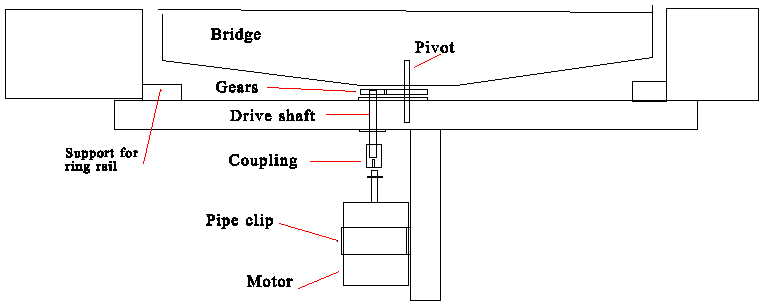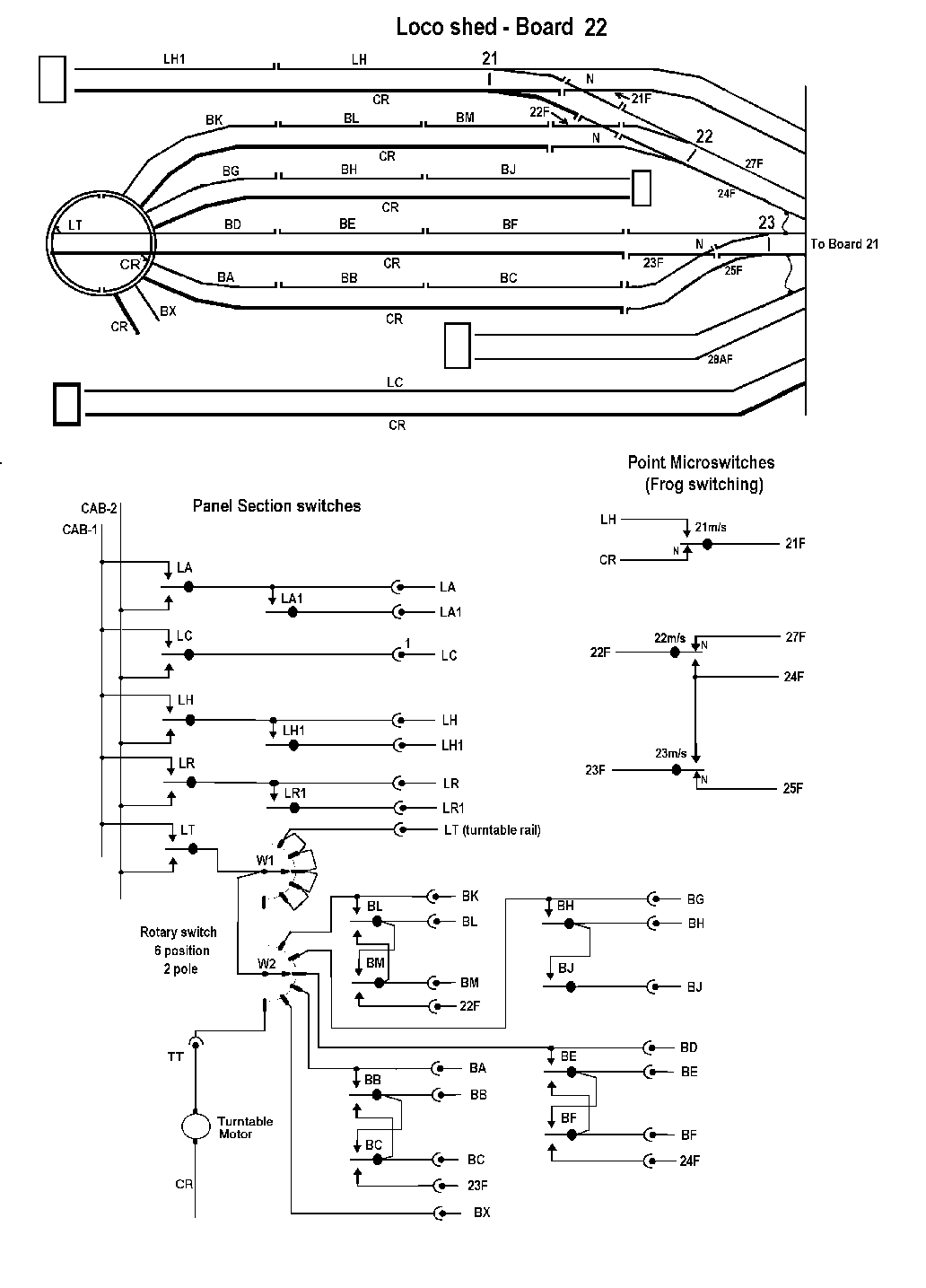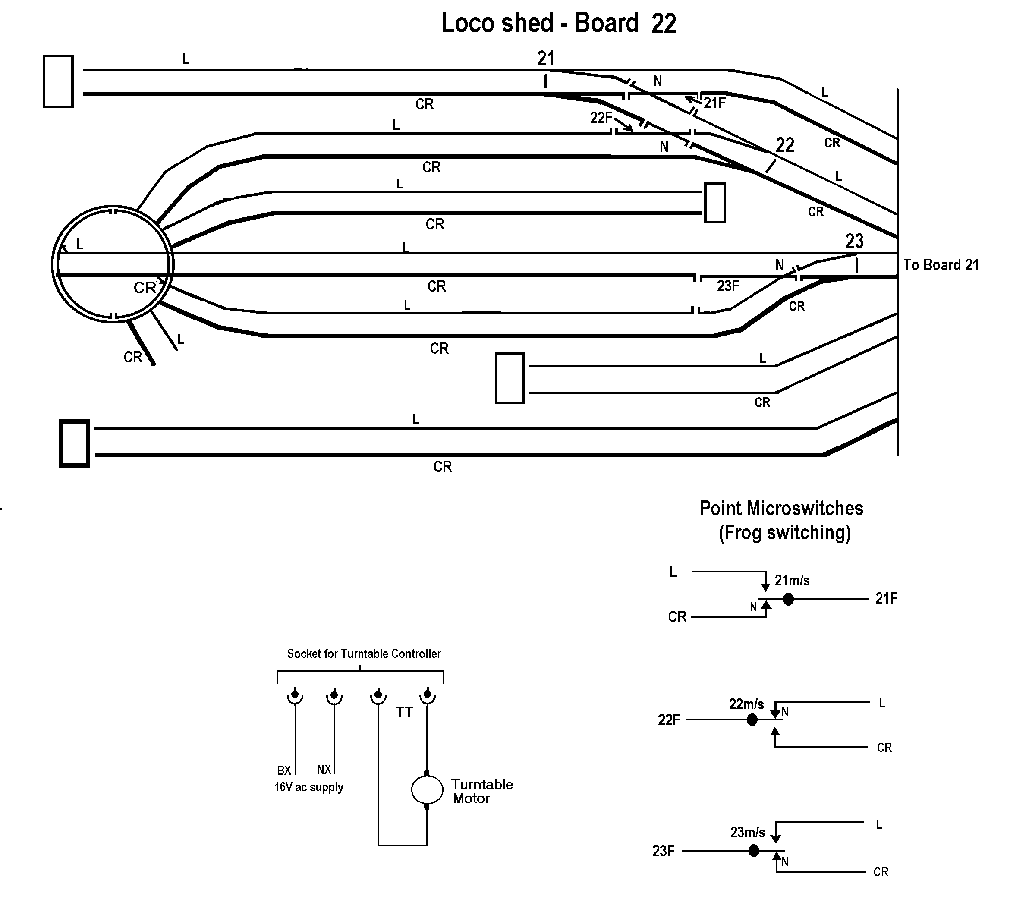

The turntable bridge sits in the pit supported by the ring rail and located by a fixed pivot pin which enters a bearing in the centre of the pit. This pivot pin carries a spur gear fixed under the centre of the bridge. A drive shaft is installed in the turntable pit floor offset from the turntable centre such that a spur gear on the top of the drive shaft meshes with the spur gear under the bridge when the bridge is lowered into position. The drive shaft carries a sleeve coupling at the bottom. An Hankscraft display motor is mounted vertically under the drive shaft so that a cross pin through the motor shaft engages in the sleeve coupling.

Motor held in place by a pipe clip, supplied as the mounting when purchasing the
American Switch and Signal style switchmotor.

Bridge; Any ready made, kit or scratch turntable bridge can be used (Mine is adapted
from an Airfix/Dapol kit). To work correctly the bridge should be supported off the ring
rail. Usually the kits are provided with a two wheel carriage at each end, one of these
should be pivotted (equalised) to give three point support to the bridge.The main bridge
pivot pin needs to be rigid and vertical to keep the table accurately centered and to give
a constant mesh for the gears.I used a piece of copper clad paxolin (unetched circuit
board) approximately 25mm square glued to the top and bottom of the girder assembly and
soldered the pivot pin in place. The spur gear was then soldered to the pin immediately
below the girder. The pin can be any convenient diameter to suit the spur gears you are
using. Mine is 2.4mm (3/32"). Approximately 1/2" of the pin should protrude
below the gear in order to locate in its bearing in the pit bottom.

Pit; This needs to be constructed to the depth appropriate to your table, the pit floor should be made of ply or chipboard at least 1/2" thick to provide good support to the drive shaft. This shaft is supported in bearings in two brass plates screwed above and below the pit floor. The top plate carries bearings for the table pivot and for the drive shaft. A brass plate of at least 1mm and better 1/16" thick should be used to give a robust bearing and the bearing holes should be carefully drilled to suit the shaft diameters using the spur gear set as a guide to ensure correct mesh. I used a 2:1 gearset from Mikes models installed with the larger gear on the bridge.

This gives a realistic speed with the 4 rpm hankscraft motor and ample torque to deal with heavy locomotives. A 3:1 gearset should also be OK but higher ratios would slow down the table too much. I used Sharman wheels gearsets which were readily available here in UK at the time, equivalent gears are available from NWSL in Seattle. Another pair of holes in the bearing plate allow it to be screwed in place, location of these screw holes is not critical, just keep them away from the gears.. A similar plate with only one bearing hole should be made for the underside of the pit floor.
To install the bearings first drill vertically through the pit at the turntable centre
the same diameter as the bearing hole and use a piece of shafting to locate the top plate
while you screw it down. A second vertical hole, bearing size can then be drilled for the
drive shaft, using the plate as guide. Use a piece of shafting in this second hole to
locate the bottom plate and screw that in place. Both plates can then be removed, the
holes in the pit floor enlarged a little so that the shafts will turn freely and the
plates screwed back making sure to use the same screw holes.The smaller spur gear can now
be soldered to the end of a length of shafting and installed in the drive shaft holes with
a couple of washers under it. The height of the gear should be adjusted so that it meshes
nicely with the bridge gear when the bridge is sitting on the ring rail. Ensure there is a
millimeter or so clearance under the bridge gear so that all the weight is carried by the
ring rail.

Once this adjustment is made and the table and gears rotate freely, the drive shaft can be cut to length leaving 1/4" to 3/8" below the floor. A socket now needs to be soldered to this shaft to couple with the motor shaft. The motor shaft is 1/8" diameter and comes drilled for a cross pin, so what is required is a slotted sleeve which will be a loose fit over the motor shaft so the slots engage the pin. Make the slotted sleeve from 5/32" inside diameter tube and then arrange a bush from smaller tubes to give a good fit on the drive shaft. This should be soldered in place to retain the drive shaft in position and to transmit the torque. As an alternative a ready made brass universal joint can be used but as this coupling has to transmit a lot of torque press fit plastic universals as used for locomotive drives will not be strong enough.
A motor mount should now be arranged to hold the motor vertically under the pit floor
with the coupling engaged. I used the pipe clip supplied with the motor screwed to a
strategically placed piece of timber.

The turntable is driven round manually using a normal model railway train controller. Power for the trains is carried to the bridge rails through the table ring rail and the table carrying wheels, the polarity is automatically switched to suit the approach track.
My table was originally wired for conventional block control and has since been altered for DCC so both versions are detailed below.
The turntable bridge is a drop in, lift out design requiring no fixing, consequently no direct wires to the bridge are possible. The power to the rails is collected from the support wheels at each end.
Before doing anything else connect the motor wires to a power pack and give it a whirl. The wiring I used is given in the following sections.
For DC control the locomotive yard has to be broken up into locomotive size sections individually powered so that any locomotive can be moved independently. I made the turntable into one of the cab sections for the yard and had subsections on the radiating roads. A 6 position selector switch for the table directed power to the table and any one of the 5 radiating roads, the 6th position isolated the tracks and connected the controller to the table motor. Operating procedure was thus to select position 6, drive the table to line up with the required road, select the corresponding switch position, turn on sufficient subsidiary sections to reach the required berth, then move the loco.

For me the elimination of the locomotive yard panel with its multiple section switches was a significant benefit of DCC control. With DCC all table approach tracks are live at all times and, prototypically, it is possible to drive into the pit when the table is aligned to another track - drivers must be careful. It would have been possible to provide a DCC decoder for the turntable motor and allocate it an address, however, as I had standard controllers no longer required for train control I decided the simplest solution was to drive the table from its own dedicated controller.

Keith Norgrove, 14/11/98.
Copyright Keith Norgrove. Last revised: July 9th, 2011